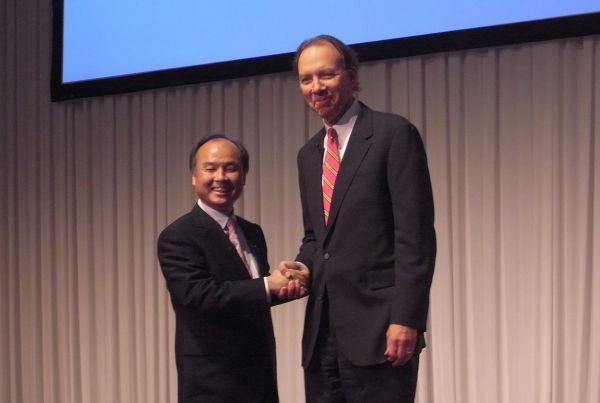My first GigaOM report / article is up today! http://research.gigaom.com/report/further-impacts-from-the-softbank-sprint-merger/
【書評】「あるある」に彩られたグローバル戦略の「キモ」とは - 「グローバル・リーダーの流儀」
著者の森本作也さんは、地元日本人仲間でもありスタンフォードMBA仲間でもある。地元の奥様方に「he is hot!」と騒がれるイケメンでもあるが、そういうワケで私とは単にそういう関係である。(誰も疑わないと思いますが念のため(^^ゞ)
だいぶ前になるが、私は森本さんとSFの野球場の向かいにあるレストランで昼飯を食いながら、「日本の企業ってミッション・ステートメントがないよね」という話をしたことがある。この話は、私自身の著書「ビッグデータの覇者たち」でも書いているのだが、単に「お金を儲ける」だけでは、長期的にはお客も従業員もついてこない。特に、日本からアメリカに進出するという場面で、さらに製品がモノを言う製造業でもない場合、そこを明確にして、共感を得られないとうまくいかないよね、と話したのだ。日本企業でも、私の古巣であるホンダは珍しく「理念」がはっきり言語化されていて、日本でも繰り返し従業員に伝えられ、実行され、対外的にもそれが広く認識されているのだが、森本さんは「そういえば、ソニーはそれがなかったな・・」という感想を発したので、私は少々驚いた。
そのときに引き合いに出したのが、楽天だった。もう済んだことなので申し訳ないが、具体的な例があったほうがわかりやすいと思うので書いてしまう。当時、楽天は海外進出のエンジンをかけだした頃で、アメリカから楽天のサイトにアクセスしようとすると、かなりダサい英語版のサイトにしかはいれないとか、いろいろとまだまだな時期だった。その英語版サイトの「About Us(企業情報)」のページに行くと、ミッション・ステートメントが掲げられていたのだが、それは「世界一のインターネット企業になる」というものだった。まぁ、社内的に商売の目標としてこれを掲げるのは構わないのだが、楽天に無縁なアメリカ人が「お客」や「投資家」や「パートナー」や「同業者」の立場からこれを聞いても、「へー、そーなの」で終わりだ。なんらかの共感を覚えて、この企業はいいね、このサイトを使おう、ここと商売しよう、と思えるとっかかりが何もない。シリコンバレーの企業はなんだかんだで理想主義的なところがあるので、グーグルならば「世界中のあらゆる情報を整理してリーチできるようにする」などといった、世の中をよくする方向での理念があるし、ホンダも「人間尊重、3つの喜び」など一連のコンセプトがはっきりしていて、多くの人が共感を持つことができる。
楽天の場合は、コレじゃチョットね・・と思いつつ、でも理念がないワケじゃないはずだ、とも思っていた。シリコンバレーほどでないにしても、日本でも無数の企業がある中で、ここまでのし上がってきた背景には、何か必ず、多くの人の支持を得られる理念の柱があるはずなのだ。しかし、日本人はそういうことを言葉ではっきり言うと「偽善」とか「カッコつけ」とか言われてしまうので、あえて露悪的な「ナニワ金融道」的な、現実の商売は厳しい的なことを言うのがカッコいいような、歪んだ自意識があって、はっきりその理念の柱を自覚しない。あるいは、某社のように、言ってみたけれど中味がついてこなくてスベリまくり・・と批判されるのを怖がって予防線を張っている、のかもしれない。でも、スベるリスクも引き受けて、言って実行しなきゃアメリカ人はついてこない、人事や給与体系のテクニックだけではアメリカでの企業経営はうまくいかないと思う。
・・という話を私はそのときした、と記憶している。これはその以前からずっと思っていたのだが、個別企業をクサしたくなかったので、この件はブログにも書いたことはない。代わりに楽天の経営に近い方に個人的にお話しして、そのためでもないと思うが、現在ではミッション・ステートメントもちゃんとしたものに変わっている。ということで「過去の話」で、対比する例として挙げさせていただいた。楽天のみなさま、どうかご容赦ください。
森本さんの近著、「SONYとマッキンゼーとDeNAとシリコンバレーで学んだ グローバル・リーダーの流儀」というやたら長いタイトルの本の中で、上記の件を取り上げていただいていることにまず感謝したい。最近「グローバル人材」とか「グローバル・リーダー」とかがやたらバズワードになっており、この本もそんな尻馬に乗ったモノのように聞こえるかもしれない。タイトルからすると、経営コンサルタント的な「概念的」な「堅苦しい」ものをちょっと想像するかもしれない。あるいは、海外在住者がついやってしまう、日本流の欠点ばかりをあげつらうものかと思って敬遠する向きもあるかもしれない。でも、そんなことはないので、ぜひまずは手にとって読み始めていただきたい。
物語形式で語られるエピソードはわかりやすく、米国での日本企業に関わっている人ならば、首筋違えるほどブンブン頷いてしまう「あるある」事例が満載。それでも批判一方ではなく、日本企業のもつ「良さ」も「直そうと思っても直らない欠点」もある程度肯定した上で、具体的な解決策の事例を挙げている。そして、それは具体的な「ヒント」だけでなく、上記のような「経営のキモ」の話も含んでいる。本書でも語られるように、解決策は一様ではない。このとおりやってもうまくいかないことのほうが多い。解決策はそれぞれの企業のそれぞれの問題によって異なるのだが、それを導き出すヒントには大いになるだろう。
日本以外の海外市場に共通な部分も多いが、特にシリコンバレーとつきあいのある日本企業の方であれば、シリコンバレー人の行動や心情の描写も超「あるある」なので必読である。私も、さっそくクライアントに「まずこれ読んでください、詳細な話はそれから」と勧めたいと思っている。
DoCoMo to "cut cord" with Japanese handset vendors
 DoCoMo, Japan's top mobile carrier, has been struggling. They are losing out in new subscriber add against KDDI and Softbank and there is no sign of reversing the trend, given that DoCoMo is currently the only major carrier who does not provide iPhone.
DoCoMo, Japan's top mobile carrier, has been struggling. They are losing out in new subscriber add against KDDI and Softbank and there is no sign of reversing the trend, given that DoCoMo is currently the only major carrier who does not provide iPhone.
People have been speculating the reasons why DoCoMo does not sell iPhone, and one major factor is thought to be their long standing relationships with Japanese handset vendors. If DoCoMo wants to sell iPhone, Apple would push a tough quota, thus there will be no room for already weak Japanese vendors. They say that will mean the sure death to vendors like Fujitsu and Sharp.
But alas, even without iPhone, DoCoMo decided to hand the death sentence to them, practically speaking. On May 15, they announced the strategy to push "Two-Top" smartphones, Samsung Galaxy S4 and Sony XperiaA, for their summer handset lineup. Tsutsumu Ishikawa reports on Nikkei that DoCoMo will pay extra handset subsidy for these models and strongly feature them on their advertisement.
Maybe 2 years too late, but from DoCoMo's point of view, it makes all the sense. "Global models"'s volume means they have lower cost and better proven quality, thus bring down DoCoMo's cost for procurement, customer service and other maintenance. It will make it easier for global Android developer community to write apps for DoCoMo.
Yesterday's Google I/O was quite interesting - for me, the most interesting one among the past same events. They are really pushing all kinds of tools to support Android developers so they can make money. One of them is the "global sales" direction such as language support. Not just handset vendors, but for app developers, going global is the key to success already.
And with Google's "big data" capability, they provide many personalization tools. It is no longer even thinkable for carriers to match these capabilities. Carriers have lost out in their quiet effort to compete against Google and Apple. Now even mighty DoCoMo has to go with the flow.
And by the way, some also speculate that this whole thing means that DoCoMo is preparing to make room for iPhone.
So there you have it. Looks like DoCoMo has made a big decision to cut their umbilical cord with Japanese handset vendors (except for Sony). Vendors have to find a way to support themselves now - but how?
Why DoCoMo wants to sell radish
Why DoCoMo wants to sell radish

NTT DoCoMo, the largest mobile carrier in Japan, recorded the net loss in subscriber number in November, negative 40800, first time since August 2007 and the largest loss in its history. Many explanations have been made. The easiest to understand is that they don't have iPhone in their line up while their competitors do, and some also suspect that the string of large network troubles in recent months disappointed customers who believed that DoCoMo provides the best service despite their higher price.
And Mr. Kaoru Kato, President and CEO of DoCoMo, is saying that their currently strategy is to become Amazon, according to this Sankei Biz article from last week.
WHAAAATTT????
Well, to be sure, DoCoMo has acquired Tower Records several years ago. Earlier this year, they acquired Radish Boya, an online organic vegetable delivery service. So... they want to become a company that sells radish? In the industry that is dominated by this largest and smartest company? What the xxxx is their competitive advantage as a new entrant??
It is totally impossible to understand if you look at the situation from outside, in management language. As a former NTT employee, I can sense where it comes from. NTT often behaves like a family, not a for-profit company or group where people gather to achieve a common goal. NTT's purpose is often to earn living for the existing employees (=family members), so if the day job is not enough to make ends meet, they have to get double or triple jobs to put food on the table, rather than lay off employees. In that world, family members are often more important than customers.
I hope it is not the case - that Mr. Kato actually knows what he is doing. Uggh....
Memory of the cloud brain – what is cloud storage?
 “Big Data and Cloud Storage” Trend 2: “Big Data and Cloud” Vol. 3
“Big Data and Cloud Storage” Trend 2: “Big Data and Cloud” Vol. 3
What is Cloud Storage?
◆ Memory of the cloud brain
In my previous article, I wrote that “cloud” is becoming the "brain" of the Internet world and its “thinking” activities correspond to “big data”. This time, I will talk about another brain function “memory”, which is “cloud storage”. The word “STaaS (Storage as a Service)” is used interchangeably.
Dropbox is an easy-to-understand example. To be precise, Dropbox is an end user application and cloud storage is an infrastructure for applications, but consider it as a metaphor to understand its role.
Documents are stored in the Dropbox server in the cloud. It gained popularity as the document sharing tool between the desktop and mobile devices, as a part of the web world transition to "mobile and cloud" era, as I mentioned in the first article. It is also used as a groupware to share files team members, and similar service Box is widely used by enterprise users.
These are particularly storage-centered services, but virtually all web services need storage, such as mail storage in Gmail and photo storage in Facebook
◆ “Kanban sysytem” cloud storage
Cloudian distinguishes Dropbox-like upper later file share as “online storage” and lower layer infrastructure for application as “cloud storage” for app providers. The following discussion is about the latter.
Major players such as Facebook and Google own and operate in-house storage infrastructure. However, many other online service providers strategically choose to outsource it. The major online movie streaming provider Netflix, who owns a huge amount of video and customer data, is a good example of such “cloud storage”.
Specialized consulting firm 451Group forecasts global market of cloud storage grows to $ 6.0 billion in 2015 from $ 1.3 billion in 2011. Majority is the storage-centric services ($750M → $4.7B), with backup and archiving ($550M → $1.3B) consist the rest.
451 Group defines cloud storage with two factors as follow;
1) Storage capacity can be obtained in on-demand basis. 2) Data is in a hosted environment and can be accessed via Internet.
If data amount drastically fluctuates from time to time, it is too expensive to own the storage capacity enough for the peak time, like an empty highway in the countryside. Instead, cloud storage (STaaS) can work as the Kanban system. Among the above two items, (1) is the major characteristic of cloud storage, whereas (2) is also for a traditional hosting service. This Kanban-like scalability is called "scale-out” in the cloud industry.
As mentioned in my last article, Amazon is the giant in this world. There are practically no start-ups inSilicon Valleywho don’t use the Amazon cloud service. Amazon’s cloud storage is ideal for them, as it is hard to predict the capacity requirement over time and the budget is tight.
Amazon customers include some large enterprises like Netflix, as well as those start-ups, and it is the only cloud storage vendor that their annual revenue exceeds $100M. In the 451 report, Amazon owns almost 50% market share, although there is no exact data available at hand. Salesforce.com, Rackspace, Microsoft and HP are followers.
◆ Storage system of Amazon
Amazon’s cloud storage S3 (Simple Storage Service) is a part of Amazon Web Services (AWS). “S3” has becomes de facto standard of cloud storage.
S3 uses the technology called Object Storage, one of the three storage methods:
(1) Block Storage:
Data is cut into a certain size, and mechanically stored as 1s and 0s. It is used in SAN (Storage Area Network) that requires fast access over a very short distance.
(2) File Storage:
A collection of data is stored in file format, carries metadata such as file name and file format, in a hierarchical structure of directory or folder, much like on the PC desktop. It is used in NAS (Network Attached Storage).
(3) Object Storage:
A big chunk of data is packaged like a box, including metadata, which is called an object. Each box is given an OID (Object ID), and all objects are saved in a flat manner.
File storage is easy to understand by analogy with the paper folders, but is inefficient due to several problems. The data access operation requires following the folder structure from the top to the bottom, and needs to go back to the top to move to a different folder. Metadata is located outside of a holder, and concurrent operation is problematic because the name of the upper folder is shared by multiple files
In contrast, with object storage, OID is the only key necessary to access an object, much like pulling out a whole box by looking at a tag attached to it. It is not necessary to go up and down the hierarchy and all metadata is also stored in a box.
Only one object is tied to one OID, so parallel data accessing is easy. This higher efficiency results in lower cost and high scalability, as long as the contents of the box are not changed.
With these characteristics, object storage is a preferred method for cloud storage which requires storing massive static data, such as images, videos and e-mails, and cost efficiency and scale-out ability are quite important.
◆ Challengers
Not many players challenge to the dominance of Amazon at the moment. In theUS, some companies such as Microsoft and HP serves their existing enterprise customers, slightly different customer base. Google is sometimes mentioned as a direct competitor to Amazon, but their target is small and medium-sized customers and their market share is still small. InEurope, LunaCloud has emerged as an Amazon style competitor.
InJapan, Nifty Cloud and Yahoo! Cloud have been providing similar services, and recently NTT Communications entered this field. Please see below for more details.
Panasonic to ALMOST get out from mobile handset business
Panasonic to ALMOST get out from mobile handset business.

So the Japanese press reports today. Wait.. were they still making one, anyways?
In Japanese domestic market, Panasonic kept No. 2 (after Sharp) till 2009, but as the market shifts to smartphone, now it is ranked 4th, after Fujitsu, Apple and Sharp. They just announced that they will shrink their mobile handset business drastically, discontinue Eluga product line they just introduced in Europe, already slashed several hundred headcounts in the domestic product facility. But "shrinking" even further from the current small operation equals death, practically speaking.
In a separate report, as all the carriers shift their line up to smartphone in the past few years, Japanese vendors finally turned their heavy body around and designed "state-of-the-art" smartphone, with their sophisticated technology and design ability, but it turns out that Qualcomm could not supply enough number of Snapdragon chips due to the global shortage (=dramatic sales increase). Because Japanese market and vendors are so small that they get a low priority in rationing.
And at this moment, there is really no way out of this mess. No international vendors want to buy into any of these smaller players, and merging with other weak domestic player will not help in global market at all. Sharp is on the verge of bankruptcy due to their liquid crystal problem, and Fujitsu handsets have all kinds of problems.
Even the Mighty Nokia is slipping down. Too bad, Japanese once-glorious mobile vendors are all going down together. I believe they should have consolidated themselves in early 2000's, when they still had some life left. But it is WAY too late.
Sigh...
No.2 carrier KDDI is increasing grip on cableTV, and it makes a whole lot more sense
No.2 carrier KDDI is increasing grip on cableTV, and it makes a whole lot more sense While No. 3 Softbank is buying up SprintNextel in the U.S., KDDI is increasing its control on Japanese domestic cableTV industry.
Currently, KDDI has 30.7% of No. 1 JCOM (with 39% market share) and 95.6% of No. 2 JCN (11% share). JCOM's lead investor is Sumitomo Corp., who fought with K when K tried to buy control of JCOM in 2010, ending up buying more shares than K and currently holds 40%.
Nikkei reports that this time KDDI and Sumitomo will jointly buy up 30% of JCOM shares in the open market, making it privately held with 50-50 joint venture, and then will acquire JCN to make it a subsidiary.
News reports that the new company holds 50% share of Japanese cable TV industry, although much smaller size compared to the US, and plan to become an effective competitor in fixed broadband against dominant NTT group. NTT is also entering into video distribution through Hikari TV, competing against cable TV companies.
Sumitomo Corp entanglement aside, this deal makes way more sense to me compared to Softbank-Sprint deal, looking from Japanese consumers point of view. The market has been horribly fragmented and did not have enough clout in the fight against media giants, to move video contents onto broadband. I hope it will shake the Japanese media's iron grip and finally bring it to 21st century.
Why Softbank is buying Sprint NOW
Why Softbank is buying Sprint NOW

Japan's Softbank is buying 70% of SprintNextel. "Why" from Sprint side is pretty obvious - they need money. A lot of it, for LTE deployment, and to kill 4th and under competitors.
But from Softbank side, the gain is not very clear. Today's Softbank press release talks about their synergy in building "next generation mobile internet company" and they can provide know-how of turn around. You, as an industry person, know these are just the templates. It really does not have any meat. Well, at least Yen exchange rate helps, but really, why?
Some say it is just Mr. Son's ego. He is eager to expand his business internationally, and he just could not resist the temptation of this opportunity. Others say he can gain a lot of political clout against Japanese regulatory body - utilizing US pressure, often referred as "gaiatsu" (outside pressure) in Japanese. Some Japanese analyst complain that Son should invest that money into his own network to improve its notoriously poor connection. Yes, that is true, there will be no direct benefit to Japanese subscribers.
But after all, does it worth 20 billion dollars, right after Softbank finally shrunk its HUGE debt for Vodafone Japan acquisition to a manageable size?
Well, I am guessing that Masayoshi Son is betting on Dan Hesse. Sprint has already made a lot of improvement since he took helm. They cleaned up the customer service mess, cut cost and obtained iPhone in their line up. They have done a good job in things that does not require a large sum of investment. But now they have to get onto the real network mess clean up. And also, Hesse practically throw T-mobile into a tank when he successfully blocked its merger with AT&T, and he still is trying to kick them off into a cliff, taking everyone who is climbing up under him.
If, at this moment, he gets enough money NOW and become successful? Sprint share price will shoot up. Son can pocket a huge capital gain. He can use the money for anything then, be it Japanese network improvement or his new pet project, solar power generation.
In my "telecom economy 10 year cycle" theory, now is the "down" time for both fixed and mobile network. If my theory is correct, fixed network will turn around in 2015, and mobile in 2018. Sprint is planning to finish its network transition in 2017. So it is actually a pretty good timing.
I have been involved and observed the "telecom industry globalization" and leaned that international investment into "local" portion (including mobile) of the network is VERY hard to succeed in long term, except for within Europe (their "country" is about the size of "state" in the US) and for the cases of former colonies (such as former British Empire and Spain-LatAm). But if you look at it as "5 year" turn around investment between 2012 and 2017, it looks reasonable.
As long as you believe Dan Hesse can do it as he promised. And I guess Son believes he can, and Son is betting hugely, as his once-in-a-lifetime opportunity. He is a crazy guy who bet on some smaller but similar opportunity and has been successful.
So let's see if his horse will win or lose.
From box to cloud – Random thoughts at Hosting and Cloud Conference
 “Big Data and Cloud Storage” Vol. 2: Event and Company #2
“Big Data and Cloud Storage” Vol. 2: Event and Company #2
From box to cloud – Random thoughts at Hosting and Cloud Conference
◆ Die-hard Local Businesses as “Cloud” infrastructure
It was my first time to attend “Hosting and Cloud Transformation Summit2012” held in Las Vegas on September 19th and 20th.
I enjoy feeling various beat of each industry when I attend conferences. This time, the impression of this conference was quite different from equivalent Silicon Valley ones.
I am accustomed to see Asians, Europeans, men and women all mix together, in jeans-based business casual, while the exhibit booths push fashionable and cutting-edge image, in SV. But here at HCTS, most attendees are white male in suit, and the booths are more practical and industrial. I often encounter such atmosphere at traditional telecom segments, which is supported by many local-oriented small to medium service providers.
In the 1990’s, thousands of discount long distance telephone carriers and CLECs flourished across the US. WorldCom was the most famous one, but most of them were not “money game” type people at all. They continued on as honest local businesses, have changed the line of business into another form as the industry changes, and one of their evolved form is the hosting business.
Such not-so-flashy but vast and steady infrastructure business is the building block of the cutting edge cloud services such as social media and online games.
◆ Hosting business is doing well
But their profitability is quite flashy indeed, said DH Capital, investment bank specialized in this area. They claim that after the over-supply period of the bubble, demand increased accordingly and now the market is at just a good balance. EBITDA multiple of publicly traded hosting companies are at 15-20x, nice level as a steady industry.
Traditional hosting as a “box” business can earn a steady income when the box is full. But many predict a huge demand increase in the near future, and the threat of overflow. Conference organizer The 451 Group pointed out in the keynotes the cause of such demand change is caused by “Internet of Things (IoT)” and “Big Data.”
The audience reaction felt a bit slow to these issues, another difference from Silicon Valley where people are actually feeling the pinch of data overflow. I guess it is because the data overflow situation has not spread into many other places.
◆ From Box to Cloud
But such data wave is spreading for sure.
According to The 451 Group, Internet infrastructure market is estimated to grow from $39 billion in 2010 to $68 billion in 2013, at 20% CAGR. Among its sub-sectors, the largest are traditional managed hosting and multi-tenant datacenter, but the fastest-growing is cloud computing with 62% annual growth. “Cloud” is more flexible and scalable form of service compared to “box” type traditional hosting.
Big data characteristic is often express as “3V”, or “Volume, Velocity and Variability.” The 451 Group argues that datacenter has to be elastic as well to handle such type of data communication.
Datacenter management has to adjust as well. In the conference, for example, Schneider Electronic explained that the electricity management has to be upper-layer conscious, because if the power of a part of virtual machine goes down, the management system has to know where to back up.
◆ Amazon Dominance
Looking from a different point of view, cloud service can be divided into three layers, “SaaS (Software as a Service)”, “PaaS (Platform as a Service)” and “IaaS (Infrastructure as a Service).” Hosting service providers are in IaaS area.
The 451 Group showed that approximately half of IaaS market is taken by Amazon, followed by Rackspace and Verizon Business with a wide margin. It is safe to say that Amazon S3 (Simple Storage Service) has become the de facto standard in cloud storage.
Although Amazon was not present in the conference, many speakers mentioned it in a context that managed hosting players are feeling threat from Amazon S3. The 451 Group, however, claimed that both have different roles and will co-exist even in the future.
◆ Cloudian Community Edition
In the conference, this column’s sponsor Cloudian announced free “Cloudian Community Edition”.
Cloudian software enables hosting providers and enterprise users build “Amazon Style” cloud storage system, compatible with S3.
Community Edition includes the same functionality as the standard edition and is free up to 100 Terabyte.
Please refer to Cloudian website for more details.
Shouldn't Apple forget about map and TV and worry about music?
Shouldn't Apple forget about map and TV and worry about music? I just wrote a Japanese column on Nikkei Business Online about Apple's map app problem. In a nutshell, I wrote that the trouble was caused by their lack of expertise in "cloud" and "big data". It is not due to the absence of Steve Jobs - they already have a bad track record with MobileMe and Ping - the latter being shut down yesterday.
There has been a lot of rumor about Apple's entry into TV, and I would imagine they have a capability to produce a beautiful piece of TV set - or rather, in my world, iPad is already one. But if they try to eliminate Netflix from the equation and do it on their own, I guess the same "map" type problem would happen in streaming service. They pioneered video distribution service on iTunes Store, but after that breakthrough, their iTunes service has not been improved so much. Netflix, on the other hand, is working SO HARD behind the scenes to brush up their big-data-based recommendation skills, and I believe that is the heart of their success.
Apple is working very had to catch up, aggressively hiring cloud/big-data engineers. But it will take years to accumulate data and the expertise to turn it into a viable products.
So if they have to work so hard on this area, I wonder why not start from their roots and strength, which is music service. They already have so much data in music purchases of their huge number of registered users. The report says that they are delaying "Pandora" type streaming music service due to the right negotiation problem with Sony, but even if that does not exist, I wonder if they can provide good enough interface, given they are still on the learning curve in cloud and big data.









